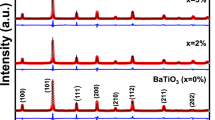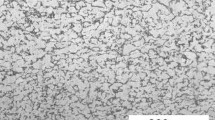Abstract
Zr–Al alloys containing up to 26 at.% aluminum, prepared by magnetron sputtering, have been anodized in 0.1 mol dm−3 ammonium pentaborate electrolyte, and the structure and dielectric properties of the resultant anodic oxide films have been examined by grazing incidence X-ray diffraction, transmission electron microscopy, Rutherford backscattering spectroscopy, and AC impedance spectroscopy. The anodic oxide film formed on zirconium consists of monoclinic and tetragonal ZrO2 with the former being a major phase. Two-layered anodic oxide films, comprising an outer thin amorphous layer and an inner main layer of crystalline tetragonal ZrO2 phase, are formed on the Zr–Al alloys containing 5 to 16 at.% aluminum. Further increase in the aluminum content to 26 at.% results in the formation of amorphous oxide layer throughout the thickness. The anodic oxide films become thin with increasing aluminum content, while the relative permittivity of anodic oxide shows a maximum at the aluminum content of 11 at.%. Due to major contribution of permittivity enhancement, the maximum capacitance of the anodic oxide films is obtained on the Zr–11 at.% Al alloy, being 1.7 times than on zirconium at the formation voltage of 100 V.










Similar content being viewed by others
References
Pringle JPS (1980) Electrochim Acta 25:1423–1437
Young L, Smith DJ (1979) J ElectrochemSoc 126:765–768
Mott NF (1987) Phil Mag B 55:117–129
Aladjem A (1973) J Mater Sci 8:688–704
Dyer CK, Leach JSL (1978) J Electrochem Soc 125:1032–1042
Habazaki H, Uozumi M, Konno H, Shimizu K, Skeldon P, Thompson GE (2003) Corros Sci 45:2063–2073
Habazaki H, Shimizu K, Skeldon P, Thompson GE, Wood GC (1997) Proc R Soc Lond A 453:1593–1609
Habazaki H, Skeldon P, Thompson GE, Wood GC, Shimizu K (1996) Phil Mag B 73:297–308
Habazaki H, Uozumi M, Konno H, Shimizu K, Nagata S, Asami K, Matsumoto K, Takayama K, Oda Y, Skeldon P, Thompson GE (2003) Electrochim Acta 48:3257–3266
Habazaki H, Uozumi M, Konno H, Shimizu K, Nagata S, Takayama K, Oda Y, Skeldon P, Thompson GE (2005) J Electrochem Soc 152:B263–B270
Habazaki H, Shimizu K, Nagata S, Asami K, Takayama K, Oda Y, Skeldon P, Thompson GE (2005) Thin Solid Films 479:144–151
Koyama S, Aoki Y, Nagata S, Kimura H, Habazaki H (2010) Electrochim Acta 55:3144–3151
Wang T, Jin ZP, Zhao JC (2001) J Phase Equilib 22:544–551
Hashimoto K, Park PY, Kim JH, Yoshioka H, Mitsui H, Akiyama E, Habazaki H, Kawashima A, Asami K, Grzesik Z, Mrowec S (1995) Mater Sci Eng A 198:1–10
Koyama S, Aoki Y, Sakaguchi N, Nagata S, Habazaki H (2010) J Electrochem Soc 157:C444–C451
Patrito EM, Torresi RM, Leiva EPM, Macagno VA (1990) J Electrochem Soc 137:524–530
Zhao XY, Vanderbilt D (2002) Phys Rev B 65:075105
Chen Y, Sellar JR (1996) Solid State Ionics 86–8:207–211
Lanagan MT, Yamamoto JK, Bhalla A, Sankar SG (1989) Mater Lett 7:437–440
Wood GC, Skeldon P, Thompson GE, Shimizu K (1996) J Electrochem Soc 143:74–83
Habazaki H, Shimizu K, Nagata S, Skeldon P, Thompson GE, Wood GC (2002) Corros Sci 44:1047–1055
Habazaki H, Shimizu K, Nagata S, Skeldon P, Thompson GE, Wood GC (2002) J Electrochem Soc 149:B70–B74
Habazaki H, Matsuo T, Konno H, Shimizu K, Nagata S, Matsumoto K, Takayama K, Oda Y, Skeldon P, Thompson GE (2003) Electrochim Acta 48:3519–3526
Shimizu K, Kobayashi K, Thompson GE, Skeldon P, Wood GC (1996) Philos Mag B 73:461–485
Habazaki H, Skeldon P, Shimizu K, Thompson GE, Wood GC (1995) J Phys D Appl Phys 28:2612–2618
Shimizu K, Kobayashi K (1995) J Suf Finish Soc Jpn 46:402–409
Shimizu K, Thompson GE, Wood GC, Xu Y (1982) Thin Solid Films 88:255–262
Brown F, Mackintosh WD (1973) J Electrochem Soc 120:1096–1102
Acknowledgement
The present work was supported in part by the Global COE Program (Project No. B01: Catalysis as the Basis for Innovation in Materials Science) from the Ministry of Education, Culture, Sports, Science and Technology, Japan.
Author information
Authors and Affiliations
Corresponding author
Rights and permissions
About this article
Cite this article
Koyama, S., Aoki, Y., Nagata, S. et al. Formation and dielectric properties of anodic oxide films on Zr–Al alloys. J Solid State Electrochem 15, 2221–2229 (2011). https://doi.org/10.1007/s10008-010-1238-y
Received:
Revised:
Accepted:
Published:
Issue Date:
DOI: https://doi.org/10.1007/s10008-010-1238-y




